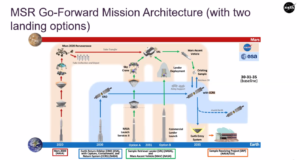Laurie Leshin Steps Down as JPL Director
Laurie Leshin is stepping down as the Director of NASA’s Jet Propulsion Laboratory on June 1. Dave Gallagher, JPL’s Associate Director for Strategic Integration, will be her successor. Leshin’s three-year tenure has been marked by great successes like the launch of Europa Clipper, but also challenges that range from protecting JPL from the fires that engulfed the Los Angeles area earlier this year to trying to find a way forward for the troubled Mars Sample Return mission.

JPL is a Federally-Funded Research and Development Center (FFRDC) operated for NASA by the California Institute of Technology (Caltech) in Pasadena, CA. Leshin also is a Caltech Vice President and will leave that role as well.
Today’s announcement said she’s leaving “for personal reasons,” but will continue as the Bren Professor of Geochemistry and Planetary Science at Caltech. Leshin received her Ph.D. in geochemistry from Caltech.
Acting NASA Administrator Janet Petro said Leshin’s “leadership at JPL has been nothing short of extraordinary. … We are grateful for her service and wish her the very best as she continues to inspire in the next phase of her career.”
JPL is renowned for its planetary exploration spacecraft, especially those that have flown past, orbited, landed, roamed and hovered over Mars. They include the Curiosity and Perseverance rovers operating there right now and the Ingenuity helicopter that made 72 flights, the first vehicle to make a powered flight on another planet. JPL spacecraft have explored many other places in the solar system, too, not to mention those in Earth orbit conducting Earth science and astrophysics observations.
Leshin was selected as JPL Director in January 2022, the first woman to head the lab. She assumed office in May 2022 as JPL and the country began emerging from the COVID pandemic.
One of her immediate challenges was dealing with a late-breaking problem on the Psyche spacecraft scheduled for launch during an August-October 2022 window to study a metal-rich asteroid by that name. Within a month of taking office she had to announce that Psyche’s launch would be delayed a year because there wasn’t enough time to test the flight software. The decision had consequences for a completely unrelated mission to Venus, VERITAS. To find the money to pay for Psyche’s delay, VERITAS was delayed three years from 2028-2031. An Independent Review Board (IRB) looking into what happened found many problems not just with the Psyche project, but broader institutional issues. The IRB gave Leshin and JPL kudos for how they responded to its many programmatic and institutional recommendations.

Psyche successfully launched in October 2023 and will arrive at the asteroid Psyche in August 2029. The mission was going well until last month when it experienced a pressure-drop in the propulsion system. A backup system is available if engineers can’t solve whatever the problem is.
Another major JPL mission, Europa Clipper, launched in October 2024 to study Jupiter’s moon Europa.

But JPL’s Mars Sample Return (MSR) mission continues to struggle and the Trump Administration wants to terminate it in the FY2026 budget request. For decades, bringing samples of Mars back to Earth where they can be examined with the most sophisticated equipment available has been a top priority for the Mars science community. JPL’s Perseverance rover is collecting the samples right now, but the challenge is gathering them and putting them in a rocket that can lift them off Mars and on their way back here.

NASA and the European Space Agency have been working on plans to do that for years, but costs kept growing. In November 2023, then-NASA Administrator Bill Nelson paused the program to look at alternative approaches. As congressional support wavered amid budget uncertainty, Leshin was forced to layoff eight percent of the JPL workforce in February 2024 and another five percent in November 2024.
In January 2025, Nelson decided to leave it up to the Trump Administration to decide how to proceed. Their decision is to cancel “the grossly overbudget” program. Congress could decide to fund it anyway, but the Administration’s budget proposal doesn’t kill just MSR, but cuts the entire NASA science budget by almost 50 percent.
On top of all of that, Leshin had to deal with the California fires that encroached on the lab in January. JPL’s own fire department successfully worked around the clock for days along with local firefighters to protect the lab, but about 200 JPL workers lost their homes. For the first time in JPL’s history they had to implement an emergency plan to move control of the Deep Space Network to Goldstone, CA where the DSN antennas are located. The DSN system is the only way to communicate with all those spacecraft out beyond Earth orbit including the Mars rovers, the James Webb Space Telescope, Psyche, Europa Clipper, and many, many more.

In a thread on Bluesky (@laurieofmars.bsky.social), Leshin said it was a difficult decision, but the “right one for me, my family, and the lab.”
After serving as Director of NASA Jet Propulsion Laboratory and VP of Caltech for three years, I have decided to step down, effective June 1. Though not an easy decision, I strongly believe it is the right one for me, my family, and the Lab. https://www.jpl.nasa.gov/news/dave-gallagher-named-11th-director-of-jpl-as-laurie-leshin-steps-down/
I’ll continue at Caltech as Bren Professor of Geochemistry and Planetary Science, and will leave JPL in the very capable hands of Dave Gallagher, whom I strongly support as the Lab’s 11th Director. I will focus on re-starting me research program and helping my family recover from the Eaton fire.
Leading JPL has been the honor of a lifetime. I am proud of the many things we accomplished together – launching and making progress on a long list of missions, driving the forefront of technology on Earth and in space, and making more amazing scientific discoveries than I can name.
Thank you to everyone who helped us celebrate many successes and who supported us through challenges. I will always remain a champion of JPL’s extraordinary work to expand humanity’s reach into the cosmos and make lives better on Earth.
Caltech selected Dave Gallagher, JPL’s associate director for Strategic Integration, as Leshin’s successor effective June 2. Since 2016, he has overseen Strategy, Technology and Formulation for the lab.

An electrical engineer who joined JPL 36 years ago, Gallagher has served as director and deputy director for Astronomy, Physics, and Space Technology; manager of JPL’s Advanced Optical Systems Program Office; manager of the Spitzer Space Telescope; and led the team that built and tested the Wide-Field/Planetary Camera-2 (WF/PC-2) that fixed the Hubble Space Telescope’s flawed primary mirror.
He said he wishes Leshin well and “We have exciting opportunities ahead helping to advance our nation’s space agenda and a fantastic team to help realize them.”
Petro expressed confidence in Gallagher’s ability to lead JPL with his “decades of experience, a steady hand, and a deep understanding of what makes JPL unique.”
This article has been updated.
User Comments
SpacePolicyOnline.com has the right (but not the obligation) to monitor the comments and to remove any materials it deems inappropriate. We do not post comments that include links to other websites since we have no control over that content nor can we verify the security of such links.